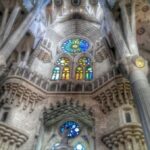
Barcelona is a city renowned for its rich architectural heritage, where the Modernisme movement has left an indelible mark. The city showcases a unique blend of creativity, color, and innovation, making it a paradise for architecture enthusiasts and tourists alike.
Among the most captivating sights are the Famous Modernist Buildings in Barcelona, which are celebrated for their organic forms, intricate details, and vibrant mosaics. These masterpieces not only reflect the artistic vision of their creators but also embody the spirit of a transformative era in Catalan history.
Significant Modernist Architects Who Shaped Barcelona's Skyline
Barcelona's skyline is dramatically shaped by the vision of several significant modernist architects whose innovative designs pushed the boundaries of traditional architecture. Among these pioneers, Antoni Gaudí stands out for his distinctive style that integrates nature and architecture. His works, including the iconic Sagrada Família and Park Güell, showcase a unique approach that has captivated visitors from around the world.
Another notable figure is Lluís Domènech i Montaner, whose creations, such as the Palau de la Música Catalana and Hospital de Sant Pau, reflect a harmonious blend of functionality and ornate design. Domènech i Montaner emphasized the importance of using local materials and artisanal craftsmanship, which became a hallmark of the Modernisme movement.
The work of Pere Casells should not be overlooked, particularly for his involvement in the transformation of the Eixample district. His designs are characterized by a focus on urban planning that facilitated the city’s expansion while maintaining aesthetic coherence. In addition, architects like Josep Puig i Cadafalch contributed significantly with buildings like Casa Amatller, known for its rich decorative elements and historical references.
In summary, the legacy of these influential architects is evident throughout Barcelona's urban landscape. To appreciate their contributions, consider exploring:
- Antoni Gaudí - Sagrada Família, Park Güell
- Lluís Domènech i Montaner - Palau de la Música Catalana, Hospital de Sant Pau
- Pere Casells - Eixample district urban planning
- Josep Puig i Cadafalch - Casa Amatller
Exploring the Unique Features of Barcelona’s Modernist Architecture
Exploring the unique features of Barcelona's Modernist architecture reveals a fascinating interplay between artistic creativity and functional design. This architectural style is characterized by its use of natural forms, vibrant colors, and intricate details that often draw inspiration from the surrounding environment. The exuberance of Modernisme is evident in facades adorned with handcrafted tiles, sweeping curves, and organic motifs that evoke the beauty of nature.
One of the most distinctive aspects of Modernist buildings is their emphasis on ornamental craftsmanship. Architects often collaborated with artisans to create stunning mosaics, sculptures, and stained glass that enhance the overall aesthetic. Notable examples include:
- Decorative ironwork found in balconies and gates
- Colorful ceramic tiles, known as trencadís, used in various surfaces
- Unique wrought iron designs that serve both form and function
Moreover, the spatial organization of these buildings often reflects a harmony with the environment. Architects like Gaudí incorporated natural light through large windows and open spaces, creating an inviting atmosphere. This focus on natural elements not only enhances the visual appeal but also promotes a sense of well-being among inhabitants and visitors alike.
In addition to their aesthetic qualities, Barcelona's Modernist buildings also serve as a testament to the city's cultural identity. They represent a transformative period in Catalonia's history, where innovation and tradition coexisted, leading to a unique architectural language that continues to inspire and captivate audiences around the globe.
Top Modernist Landmarks to Visit in Barcelona
When visiting Barcelona, exploring its top Modernist landmarks is a must for anyone interested in architecture. The city's unique style, characterized by organic forms and elaborate decorations, offers a delightful experience. Here are some of the must-visit landmarks:
- Sagrada Família: Gaudí's magnum opus, still under construction, is known for its intricate facades and towering spires.
- Casa Batlló: Another Gaudí masterpiece, this building features a colorful mosaic exterior and a roof that resembles a dragon's back.
- Palau de la Música Catalana: Designed by Lluís Domènech i Montaner, this concert hall is renowned for its stunning stained-glass skylight and ornate detailing.
- Hospital de Sant Pau: A UNESCO World Heritage site, this complex showcases beautiful gardens and buildings, reflecting the healing philosophy of its designer.
Each of these landmarks embodies the spirit of the Modernisme movement, showcasing the integration of art and architecture. Visitors will find that the vibrant colors, artistic motifs, and innovative designs create an immersive journey through the city's cultural heritage. Additionally, the following architectural features highlight the essence of Barcelona's Modernist style:
- Curvilinear forms that mimic natural shapes.
- Use of trencadís, a mosaic technique utilizing broken tile fragments.
- Richly decorated facades that tell stories of Catalan identity.
Barcelona’s Modernist architecture is not just about aesthetics; it represents a historical narrative of innovation and artistic expression. The interplay of light and space within these buildings creates an inviting atmosphere, making them perfect for leisurely exploration. For a comprehensive experience, consider taking guided tours that delve into the stories behind these architectural wonders.
In conclusion, Barcelona's top Modernist landmarks offer an unforgettable glimpse into the city's artistic soul. These buildings are not merely structures; they are vital components of the cultural landscape, reflecting a period of profound transformation. Discovering these gems will undoubtedly enrich your understanding of not only Barcelona's architecture but also its vibrant history.
The Influence of Gaudí on Barcelona's Modernist Movement
Antoni Gaudí's influence on Barcelona's Modernist movement is undeniable and profound. His visionary approach revolutionized the architectural landscape, merging natural forms with imaginative designs. Gaudí's emphasis on organic shapes and vibrant colors can be seen in his most famous works, which have become synonymous with the city itself. His ability to harmonize architecture with nature not only set a new standard for design but also inspired a generation of architects to explore the boundaries of creativity.
Gaudí's architectural philosophy was deeply rooted in his love for nature, which he believed should be a primary source of inspiration. This principle led him to incorporate elements such as curvilinear forms and intricate detailing into his designs. Notable features of his work include:
- The use of trencadís mosaic techniques, showcasing broken tiles in colorful patterns.
- Organic motifs that evoke the surrounding landscape, like the tree-like columns in La Sagrada Família.
- The integration of natural light through large, strategically placed windows.
Moreover, Gaudí's innovative techniques extended beyond aesthetics; he also revolutionized structural engineering. His mastery of geometry allowed him to create complex shapes and forms that defied traditional architectural conventions. This inventive spirit not only reshaped Barcelona but also laid the groundwork for future Modernist architects who followed in his footsteps, encouraging them to think outside the box and embrace unconventional materials and methods.
Today, Gaudí's legacy is a vital part of Barcelona's identity, as visitors from around the world are drawn to his masterpieces. Exploring his works offers a glimpse into the heart of the Modernist movement, reflecting a period of artistic exploration and cultural pride. The ongoing admiration for Gaudí's buildings underscores their significance in the broader narrative of architecture and art in the 20th century.
A Guide to the Most Iconic Modernist Buildings in Barcelona
Barcelona’s Modernist architecture not only showcases stunning aesthetics but also embodies a rich narrative of cultural evolution. The movement flourished during the late 19th and early 20th centuries, characterized by a departure from traditional architectural norms. This period fostered a unique blend of creativity and functionality, resulting in buildings that resonate with artistic expression and societal progress. Exploring these iconic structures offers insight into the city’s embrace of innovation and its quest for a distinct identity.
Among the notable examples of Modernist architecture, Casa Milà, popularly known as La Pedrera, stands out with its undulating stone facade and wrought-iron balconies. Designed by Antoni Gaudí, this building is renowned for its innovative use of space and light, reflecting the architect's fascination with natural forms. Visitors can explore its rooftop, adorned with whimsical chimneys that serve as a testament to Gaudí's imaginative genius. Additionally, Casa Vicens, the architect’s first major project, showcases vibrant ceramic tiles and lush garden spaces, highlighting the eclectic influences that shaped Gaudí's early work.
Another architectural gem worth noting is the Casa Amatller, designed by Josep Puig i Cadafalch. This building features a stunning neo-Gothic facade that incorporates intricate sculptures and colorful mosaics. Its design reflects a harmonious blend of modernist elements with historical references, demonstrating how architects of the time drew from various styles to create something uniquely Catalan. The building's interior is equally captivating, with carefully crafted details that invite visitors to appreciate the artistry embedded in every corner.
In addition to these landmarks, the Hospital de Sant Pau merits attention as one of the largest Art Nouveau sites in the world. Designed by Lluís Domènech i Montaner, this complex not only served a vital role in healthcare but also stands as a symbol of architectural excellence. Its colorful tiles, intricate sculptures, and landscaped gardens exemplify the ideals of the Modernisme movement, merging beauty with functionality. Together, these buildings tell a story of Barcelona’s architectural evolution and its enduring legacy in the world of design.
Understanding the Cultural Impact of Modernism in Barcelona
The cultural impact of Modernism in Barcelona extends far beyond the stunning facades of its buildings. This architectural movement served as a response to the social and political changes occurring in Catalonia at the turn of the 20th century. The **Modernisme** style not only showcased innovative designs but also became a symbol of Catalan identity and pride, reflecting a desire for cultural independence. The integration of art into everyday spaces transformed the city’s aesthetic landscape, making it a canvas for artistic expression.
Modernism played a crucial role in fostering a sense of community and civic engagement. The movement encouraged collaboration among architects, artists, and craftsmen, leading to the creation of public spaces that were both functional and beautiful. Key features of this cultural evolution include:
- The establishment of art nouveau as a unifying style across various disciplines.
- Increased public interest in the arts, leading to a flourishing cultural scene.
- A commitment to using local materials and craftsmanship, reinforcing regional identity.
Furthermore, the Modernist buildings of Barcelona have become significant tourist attractions, drawing millions of visitors each year. These architectural marvels serve not only as reminders of the city’s rich history but also as educational resources that highlight the interplay between art, society, and architecture. Their preservation is vital for maintaining the cultural heritage, as they encapsulate the revolutionary spirit of a bygone era that continues to inspire contemporary design.
In conclusion, the cultural impact of Modernism in Barcelona is deeply embedded in the city’s identity. The movement symbolizes a transformative period marked by artistic innovation and social progress, shaping not only the urban landscape but also the collective consciousness of its inhabitants. Understanding this impact enriches one’s appreciation of the city and its ongoing narrative of creativity and resilience.
 Catalonia Sagrada Familia Hotel: An Unforgettable Stay in Barcelona, Spain
Catalonia Sagrada Familia Hotel: An Unforgettable Stay in Barcelona, Spain Magnificent Sagrada Familia Interior
Magnificent Sagrada Familia InteriorIf you want to know other articles similar to Famous Modernist Buildings in Barcelona you can visit the category WHERE YOU CAN GO.
Leave a Reply










Read more!